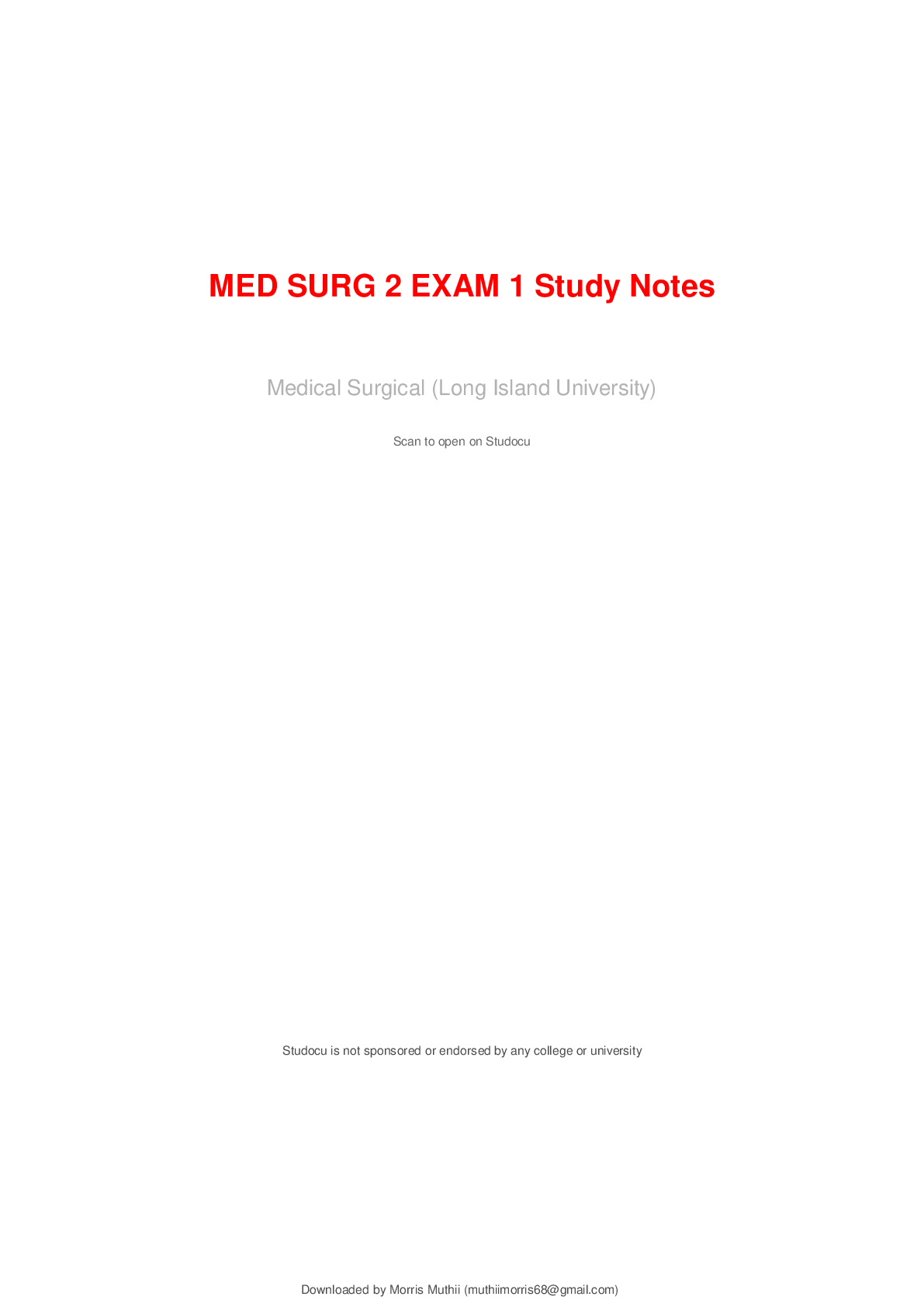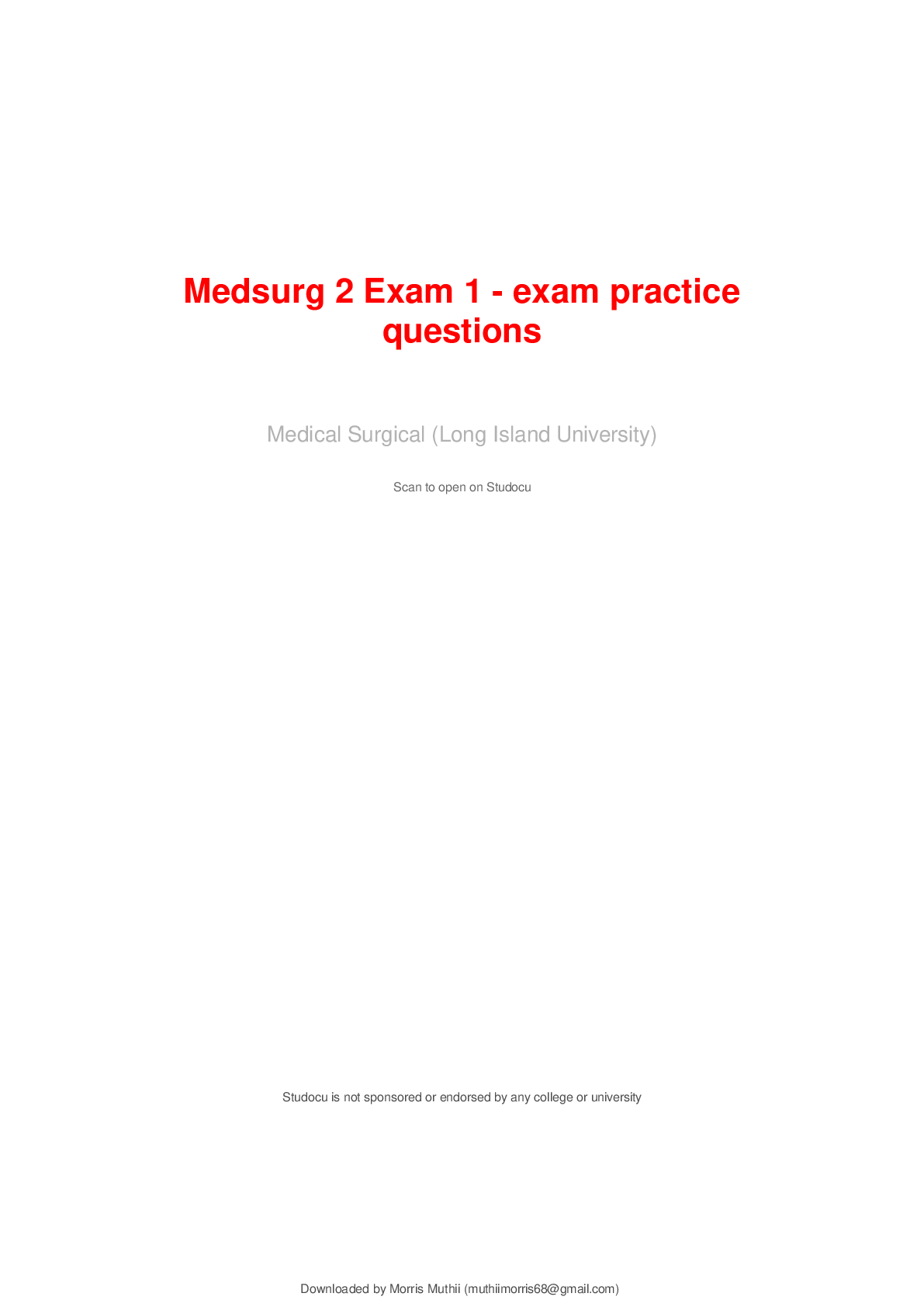ATI Med Surg > Summary > Med surg week 9 , 10 , 11 , 12 wk 13 is exam (All)
Med surg week 9 , 10 , 11 , 12 wk 13 is exam
Document Content and Description Below
Functions of Kidney; -produce urine - eliminated excess waste and toxicity - Uremia (urine goes into bloodstream) -water volume or hydration status - fluid volume excess -Blood Pressure regulation - U... NCONTROLLED HYPERTENSION -electrolyte balance / regulation - prone to develop cardiac dysrhythmia -Acid Base Balance - Metabolic acidosis -Erthyropoietin - stimulate bone marrow to produce RBC - issue with Anemia -Vitamin D production - calcium absorption - renal osteodystrophy - fracture and falls UREMIA: hemodialysis 3x a week or kidney transplant 1. 2. 3. 4. 5. 6. 7. Can go to brain - uremic encephalopathy - delirium , acute confusional state Can go to heart - uremic pericarditis - positional chest pain Can go to lungs - uremic lungs / uremic pneumonitis - DOB / SOB Can go to GI tract - uremic gastritis - GI bleeding give proton pump inhibitors - prone to develop constipation taking iron, phosphate binders given , fluid restriction , activity restriction Can go to Skin - uremic frost - super dry skin and itchy Can go to oral cavity - uremic breath or uremic fetor - breath smells like shit - oral hygiene Can go to nerves - uremic neuropathy - pins and needles - restless leg syndrome - give GABAPENTIN and PREGABALIN What can lead to body weakness ; anemia , metabolic acidosis , nutritional imbalance , depression , dialysis , lack of movement Pt can develop: - sexual dysfunction - Risk for infection - Risk for bleeding - Depression - Slow death for all vital organs - slowly damaging vital organs one by one Downloaded by Morris Muthii (muthiimorris68@gmail.com) Complications of Renal Failure; a. Fluid overload = pulmonary edema - HOB elevated , diuretics , O2, bronchodilators , fluid restriction b. Electrolyte Imbalances; hyperkalemia - cocktail - calcium gluconate c. Hypermagnesemia - avoid antacids - milk of magnesium d. Hyperphosphatemia - calcium will drop - give them calcium acetate - SEVELAMER - can lead to cardiovascular complications and constipation - 3x a day phosphate binder phosphorus is found in sodas e. Hypocalcemia - vitamin D - CALCITRIOL f. Hyponatremia - dilutional effect - fluid and sodium restriction g. Metabolic acidosis - sodium bicarbonate - weakness , abdominal pain , decreased LOC / lethargy h. Renal Osteodystrophy - weak and soft bones - low calcium level - brain will tell parathyroid to attack and produce more PTH - the parathyroid will work overtime trying to produce calcium and will lead to SECONDARY HYPERPARATHYROIDISM give CINACALCET parathyroid releasing PTH = releasing calcium from the bones i. j. Calciphylaxis Wound- if phosphate and calcium not balanced - can lead to sepsis Anemia of CKD - Iron (oral) Iron (IV - anaphylaxis) - Epoetin Injection (do not give if hgb over 10) Blood transfusion k. Uncontrolled Hypertension - hypertensive crisis - beta blockers , CCB, ACE / ARBS , Vasodilator ; HYDRALAZINE l. Stroke : 81 mg of aspirin every day give them antihypertensives every day Downloaded by Morris Muthii (muthiimorris68@gmail.com) m. Myocardial Infarction - 81 mg of aspirin combined with clopidogrel ; give STATINS ; low sodium and low saturated fats IMMEDIATE CAUSE OF DEATH: 1. dead kidney = increased water volume = fluid overload = pulmonary edema = death (resp failure) Pulmonary edema classic sign - pink frothy sputum , DOB/SOB, crackles , hypoxemia - elevate the HOB followed by oxygen and then IV push diuretics (furosemide) 2. Electrolyte Imbalance - develop CARDIAC DYSRHYTHMIA- (K , Ca, Mg) muscle weakness or muscle cramps : Electrolyte Imbalances- hyperkalemia, hypermagnesemia, hyperphosphatemia , hypocalcemia , hyponatremia (dilutional effect) LONG TERM CAUSE OF DEATH: why you die on dialysis / renal failure 1. 2. Brain - stroke Heart - myocardial infarction - heart attack *these causes of death are the same for DM* Nursing Management 1. 2. 3. 4. 5. 6. 7. 8. 9. Vital signs Fluid restriction 1L fluid restriction Daily weights Strict I&O Fall precautions and safety precaution Bleeding precautions Monitor skin integrity Monitor lab results Patient teaching - meds side effect 10. Patient teaching - complications of illness 11. Patient teaching - self management 12. 5 year rule they die from MI , stroke - should have advance directives 13. Collaborate with other members of healthcare team 14. Renal diet dietician — low potassium , phosphorus , sodium , calculated protein , increase calcium , fluid restricted 15. Activity and exercise 16. Anemia - frequent rest periods - avoid strenuous activity 17. Infection prevention 18. Dialysis care - dialysis access care - fistula vs graft Downloaded by Morris Muthii (muthiimorris68@gmail.com) 19. Regular follow up with provider 20. Emotion support and psychosocial support - depression 21. Healthy lifestyle - no smoking , no drinking 22. Prepare patient for any diagnostic tests - check for allergy metphormine for contrast dye 23. Always review their list of medication for interactions - avoid herbal and OTC meds without telling your Dr. Downloaded by Morris Muthii (muthiimorris68@gmail.com) 04.03.23 Autoimmune Disease: production of autoantibodies - antibodies will attack own body - No specific etiology / no specific cause - More common amongst women - blame on hormones develop during childbearing years (15-45) - Sometimes will be blamed on genes, environment, viral trigger (viral infection) - Cold climates - low level of vitamin D. - scientifically proven ** - Antigen - foreign material that wants to penetrate body - no beneficial effect on your body as soon as brain senses foreign antigen the brain will stimulate the immune system to produce ANTIBODIES - Antibody - attacks the antigen - in autoimmune you produce antibodies even if no antigen present ORGANS AFFECTED: almost all parts of body ; MULTI SYSTEMIC AUTOIMMUNE DISEASE 1. Brain 2. Eyes 3. Oral cavity 4. GI tract 5. Kidney 6. Skin 7. Joints 8. Lungs 9. Heart SYSTEMIC LUPUS ERYTHEMATOSUS (SLE) Lupus: body will produce antibody to attack nucleus in the cell Two BLOOD TESTS: Cell -> nucleus -> antinuclear antibody (ANA) Nucleus -> DNA -> antiDs- DNA antibody - Women Demographics / Incidence - African Americans / Native Americans / Asians General Features of autoimmune disease: - Bad : life long (chronic) - Good : you don’t have it every day - if active symptoms = FLARE UP or acute exacerbation ; quiet = remission - Multiple autoimmune conditions: if you have one autoimmune conditions , you can have other , Rheumatoid arthritis , DM - More prone to develop cardiovascular complications / clots - African Americans / Native Americans / Asians have higher incidence [Show More]
Last updated: 2 months ago
Preview 5 out of 25 pages

Loading document previews ...
Buy this document to get the full access instantly
Instant Download Access after purchase
Buy NowInstant download
We Accept:

Also available in bundle (3)

Test Bank Medical-Surgical Nursing, Clinical Reasoning in Patient Care, Gth LeMone – Burke – Bauldoff – Gubrud 2025-2026 Latest
example of the core competency evidence-based practice. Collaboration between disciplines to provide continuous and reliable care is an example of the core competency teamwork and collaboration. C...
By NurseBailley 2 months ago
$70.5
7

Medsurg cardiac meds, CAD, angina (part1)
Systemic Transport: Process of providing enough blood, oxygen, and nutrients to the cells of the body. -Heart begins to beat at 8 weeks gestation -Our heart needs 70-80% of Oxygen and is perfused du...
By NurseBailley 2 months ago
$42.5
4

Med surg week 9 , 10 , 11 , 12 wk 13 is exam
Functions of Kidney; -produce urine - eliminated excess waste and toxicity - Uremia (urine goes into bloodstream) -water volume or hydration status - fluid volume excess -Blood Pressure regulation - U...
By NurseBailley 2 months ago
$45.5
4
Reviews( 0 )
$20.50
Can't find what you want? Try our AI powered Search
Document information
Connected school, study & course
About the document
Uploaded On
Mar 15, 2025
Number of pages
25
Written in
Additional information
This document has been written for:
Uploaded
Mar 15, 2025
Downloads
0
Views
16



